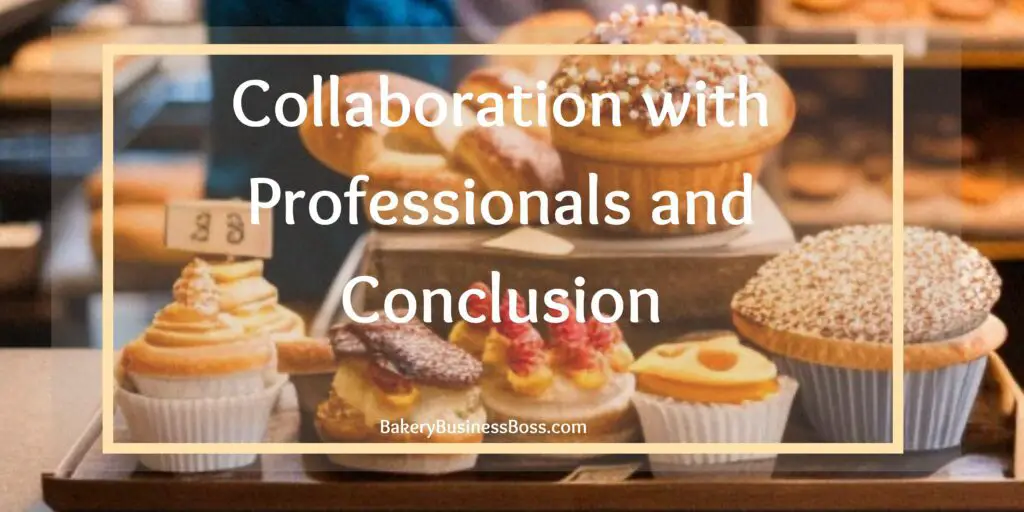Designing a bakery floor plan requires careful consideration of numerous factors to ensure effectivity and efficiency of your shop. A bakery floor plan that is well-designed contributes to increased productivity, customer satisfaction, and overall accomplishment.
To best design a bakery floor plan, you should prioritize considerations such as efficient workflow, proper equipment placement, ample workspace, clear customer flow, designated storage areas, adherence to safety regulations, and creating a visually appealing ambiance.
This article will examine the essential elements of bakery floor plan design and guide how to prioritize factors for optimal results.
Efficient Workflow for Enhanced Productivity

The key to every productive bakery enterprise is efficient workflow. A well-thought-out floor plan for a bakery helps streamline operations by highlighting important production phases and procedures. Bakery operators may efficiently arrange workstations, streamline staff movements, and ensure optimum equipment placement by evaluating workflow patterns and operations.
Baking, decorating, packaging, and storage are only a few of the manufacturing processes that bakery operators must first recognize. Other stages include ingredient preparation, dough mixing, baking, and storage. Understanding the process from beginning to end enables a thorough assessment of the significance of each stage and its effect on overall productivity.
Owners of bakeries can strategically arrange workstations based on the order of tasks if they have a thorough understanding of the process. Workstations should be arranged logically to reduce unnecessary mobility and the time and effort needed to complete each activity. For instance, setting up workstations in a linear flow from the stage of preparing the ingredients to the stage of final packaging can provide a simple and effective process.
Optimizing staff mobility is crucial for boosting efficiency in addition to workstation placement. The number of needless steps is kept to a minimum, and the distance between workstations is minimized. Bakery operators can reorganize the layout to generate more efficient channels by examining employee movements and locating potential bottlenecks or regions of congestion.
Another important element in streamlining the process is the placement of equipment properly. Equipment should be properly placed to minimize downtime and promote a smooth transition between jobs, for as by placing mixers and ovens close to workstations. Reduces employee weariness and increases productivity by keeping necessary equipment close to workstations.
Bakery operators may create an effective workflow that boosts overall productivity by getting rid of pointless procedures, streamlining personnel routes, and guaranteeing efficient equipment placement. A well-thought-out bakery floor plan encourages smooth coordination between various production steps, cutting down on time wasted and increasing output.
A productive workflow increases productivity and raises employee happiness. When workers are productive and efficient, morale is raised and a great work atmosphere is created. Employees can concentrate on manufacturing high-quality baked goods because of reduced weariness and enhanced productivity.
Creating an effective workflow is a crucial component of planning a bakery floor plan. Bakery owners can establish an environment that encourages productivity, reduces inefficiencies, and fosters employee satisfaction by studying workflow patterns, grouping workstations logically, reducing staff motions, and strategically putting equipment. Bakeries are better equipped to meet production demands and regularly provide customers with high-quality goods when their process is well-optimized.
Proper Equipment Placement and Ample Workspace
The thoughtful positioning of equipment in a bakery floor plan is essential for streamlining productivity and making the most of available space. To reduce bottlenecks and design an effective plan, much thought should be given to the placement of important apparatus such as ovens, mixers, proofers, and other necessary items.
Bakery proprietors must first evaluate the production process and pinpoint the pieces of machinery that are essential to the business. This involves thinking about where to put the ovens, which are usually the beating heart of a bakery. By placing ovens in the center of the process, baked foods can be distributed easily and quickly, reducing the time and labor needed to move things around.
Similarly to this, mixers and other mixing apparatus should be strategically placed. It ensures a smooth transition between jobs when they are placed close to workstations that need the production of dough or batter. Minimizing pointless movement and streamlining the process, conserves both time and energy.
The location of proofers, which are used to ferment dough, should be handy for access from the baking area. This makes it possible to move proofed dough to the ovens quickly and without interfering with business as usual. A smooth and continuous baking process is ensured by placing proofers and ovens close to one another.
The location of equipment is important, but so is figuring out how much room is needed for each operation. Employees should have enough room at each desk to sit comfortably and effectively. This avoids crowding and guarantees that workers have enough space to complete jobs efficiently and without hindrance. Ample workspace allocation also encourages safety by lowering the possibility of mistakes or accidents caused by claustrophobic working conditions.
When designing a bakery floor plan, maximizing space usage is of the utmost significance. Bakery operators may ensure a smooth operation and avoid congestion in the production area by properly positioning equipment and allocating adequate spaces. For employees to work effectively without feeling crowded or constrained, proper equipment placement and workspace allocation are important for increasing employee productivity and happiness.
The thoughtful positioning of machinery and the appropriate division of work space are essential components of bakery floor plan design. Bakery owners can reduce bottlenecks, reorganize the workflow, and make the best use of available space by carefully planning how ovens, mixers, proofers, and other machines are arranged.
Employee comfort and efficiency are increased by providing them with an adequate amount of workspace, which also ensures a smooth production process. By concentrating on these elements, bakery owners can design a practical and effective layout that encourages a smooth operation and helps their bakery succeed.
Check out our article on how to design your small bakery business.
Clear Customer Flow and Inviting Ambiance

To improve the general customer experience and increase sales, a bakery floor plan must be designed to create a continuous consumer flow. Bakery operators can direct customers around the area, ease congestion, and quicken service by carefully arranging the layout and taking important elements into account.
Designing distinct entry and departure points is a key component in achieving a seamless customer flow. Customers are welcomed and the atmosphere of the bakery is set by a well-defined entryway. Exit locations that are designated make it easier to leave without misunderstanding or traffic. Bakeries can guarantee that clients can easily navigate the area by offering a clear path of access and exit.
Equally crucial is creating a sensible traffic flow inside the bakery. To choose the most effective layout, it can be helpful to examine consumer behavior and anticipate their movement patterns. Bakeries can draw customers in and entice them to browse further inside by positioning popular products or display sections close to the door. Arranging product displays in a sensible sequence and offering visible signs aid clients in finding what they need quickly and navigating the area without becoming lost.
When designing a bakery floor layout, efficiency and client comfort must be balanced. Creating a welcoming and comfortable environment for consumers is just as crucial as streamlining workflow and service times. Customers have a place to unwind and enjoy their purchases thanks to the thoughtful placement of seating places. Customers are enticed to spend more time in the bakery by the welcoming atmosphere created by cozy seats, adequate lighting, and upbeat music.
The entire client experience is also greatly improved by a visually appealing environment. The bakery’s goods are displayed attractively at the entryway, luring guests inside to look around and make purchases. The visual appeal of the area can be improved by using appropriate lighting, both natural and artificial, to showcase the bakery’s products. Customers are more likely to remember a business that uses branding, décor, and color schemes to create a unified and aesthetically pleasant experience.
While designing a bakery floor plan, a smooth customer flow is essential. Bakery owners can improve the general customer experience by creating distinct entry and departure points, creating logical traffic flow, and combining customer comfort with efficiency.
A visually pleasing environment with a warm welcome, enticing exhibit areas, suitable lighting, and cozy seating increases customer satisfaction and promotes return visits. Bakery owners can design a place that is both functional and welcoming by carefully taking into account these characteristics, providing a great experience for their consumers.
Designated Storage Areas and Safety Regulations
Effective storage is a crucial component of a well-designed bakery floor plan. Bakery operators can maintain cleanliness, assure correct inventory management, and promote simple access to necessary items by designating specialized spaces for the storage of ingredients, finished products, and packaging materials.
It’s crucial to set apart specific areas for various types of ingredients when it comes to storing. Dry commodities like wheat, sugar, and spices should be kept out of direct sunlight in a dry, cool environment.
Dairy products and other perishable substances that require refrigeration need special temperature-controlled storage containers. Bakery operators can simply discover and access the required ingredients by arranging the ingredients in distinct zones, saving time and lowering the danger of cross-contamination.
Setting aside particular locations for finished goods and packaging materials is equally important to ingredient storage. To exhibit the goods and guarantee their freshness, the bakery floor plan should include suitable shelving, racks, or display cases. Setting aside space for packing supplies like boxes, bags, and labels contributes to the organization and efficiency of the packaging process.
The design of a bakery floor plan must also consider safety rules. Both customers and employees need to feel safe at work. To remove extra heat, smoke, and aromas produced when baking, suitable ventilation and exhaust systems must be included, creating a cozy and healthful environment.
To meet safety requirements and avoid potential risks, fire safety features such as fire extinguishers, sprinkler systems, and emergency exits should be thoughtfully incorporated into the floor plan.
Another important factor is adhering to health and sanitation regulations. Maintaining a clean atmosphere is made easier by designing the layout to be simple to clean and sanitize. The risk of contamination is decreased and appropriate cleaning is made possible by leaving enough space between workstations and equipment. The floor plan should have designated handwashing facilities and stations to promote good hygiene among staff.
Bakery proprietors can create a secure working environment by implementing effective storage solutions and following safety requirements. In addition to ensuring the welfare of workers, this also assists in complying with legal obligations and avoiding penalties.
A well-thought-out bakery floor plan that emphasizes effective storage and security measures encourages a smooth workflow, boosts productivity, and helps the operation’s overall accomplishment.
Collaboration with Professionals and Conclusion

The growth of bakery floor plan design can be greatly enhanced by working together with experts from the bakery business, such as architects, designers, and professionals in collaboration. Their skill, knowledge, and experience provide insightful analysis and creative solutions that are catered to the particular requirements and objectives of the bakery.
Creating rooms that are both aesthetically beautiful and useful is their area of expertise. They may assist in transforming the bakery owner’s idea into a workable floor layout that enhances effectiveness and optimally utilizes available space. Their proficiency in layout design, spatial planning, and ergonomics guarantees a smooth operation in the bakery and efficient use of the available space.
Experts in the bakery sector have a thorough awareness of the particular needs and difficulties faced by bakeries. Their expertise in the field offers priceless knowledge about the best locations for equipment, storage options, and client flow. Bakery owners can benefit from the knowledge of best practices, new trends, and operational efficiency held by industry professionals by working together, which will ultimately result in a thriving bakery.
Bakery proprietors might gain from professionals’ capacity to think creatively and suggest original solutions while working with them. Professionals bring innovative ideas and new insights that may not have been thought of before. They may offer suggestions for effective equipment arrangements, creative storage options, and distinctive design features that could distinguish the bakery from its rivals.
Professionals also have a thorough awareness of building codes, rules, and safety requirements. They may make sure that the bakery’s floor plan complies with all applicable laws about accessibility, safety, and health. This lowers the possibility of future fines or legal problems while also assisting in the creation of a secure and compliant environment.
Careful attention must be paid to several aspects while developing an effective and functional bakery floor plan, including workflow, equipment placement, workstation allocation, customer flow, storage areas, safety rules, and atmosphere.
Working together with experts from the baking sector, such as architects and designers, adds essential knowledge and insights. Their expertise and knowledge may assist bakery owners in designing a space that maximizes production, ensures client satisfaction, and paves the way for a flourishing and prosperous bakery business.
Check out our article for more ideas in creating an effective floor plan.
Frequently Asked Questions
How can I make sure my bakery’s floor arrangement promotes effective workflow?
Analyze your bakery’s manufacturing phases and processes to ensure an effective workflow. By carefully locating workstations and equipment, you may locate bottlenecks and simplify employee flow. The layout should be optimized to reduce needless movement and increase productivity.
When designing a floor layout for a bakery, what are some crucial factors for customer flow?
Create obvious access and exit locations to help people navigate your bakery. By examining consumer behavior and designing a layout that reduces congestion, create a logical traffic flow. To deliver a great experience, strike a balance between consumer comfort and efficiency.
How can I design my bakery’s floor layout to include safety requirements?
To preserve air quality and eliminate odors, make sure suitable ventilation and exhaust systems are in place. To ensure fire safety, install fire suppression equipment and offer designated emergency exits. By including suitable trash disposal and handwashing stations in your plan, you may adhere to health and sanitation regulations.
To learn more on how to start your own bakery business check out my startup documents here
Please note that the contents of this blog are for informational and entertainment purposes only and should not be construed as legal advice. Any action taken based on the information provided in this blog is solely at your own risk. Additionally, all images used in this blog are generated under the CC0 license of Creative Commons, which means they are free to use for any purpose without attribution.

About the author. Entrepreneur and Bakery Business Fan.
Hi! I am Shawn and I am a happy individual who happens to be an entrepreneur. I have owned several types of businesses in my life from a coffee shop to an import and export business to an online review business plus a few more and now I create online bakery business resources for those interested in starting new ventures. It’s demanding work but I love it. I do it for those passionate about their business and their goals. That’s why when I meet a bakery business owner, I see myself. I know how hard the struggle is to retain customers, find good employees and keep the business growing all while trying to stay competitive.
That’s why I created Bakery Business Boss: I want to help bakery business owners like you build a thriving business that brings you endless joy and supports your ideal lifestyle.

